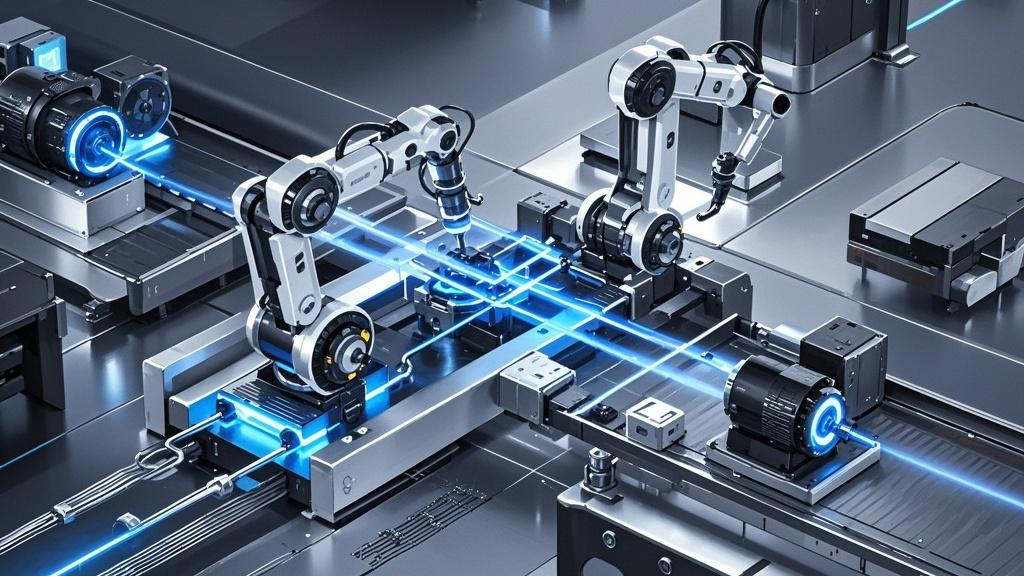
DC servo systems are an essential part of modern automation and precision control, offering efficient, precise, and responsive control over motor movement. From robotics to manufacturing and automotive applications, DC servo systems provide accurate control in a wide range of industries. This article explores the basics of DC servo systems, how they work, and key applications and the advantages of using DC servo motor and DC servo drive to enhance your understanding of these systems.
What is a DC Servo System?
A DC servo system is a closed-loop system designed for precise control of position, velocity, and acceleration. Unlike open-loop systems, which operate without feedback, a DC servo system continually monitors its output to adjust its actions for higher accuracy. This continuous feedback loop makes DC servo systems ideal for applications that require fine-tuned control and quick response, such as robotics applications using DC servo systems or high-precision CNC machining with DC servo systems.
How Does a DC Servo System Work?
A DC servo system typically consists of four key components:
1. DC Motor: The main actuator that creates movement, powered by direct current (DC). In a servo system, this motor works precisely to follow control commands.
2. Feedback Device: A feedback device, such as an encoder or potentiometer, monitors the motor’s position, speed, or acceleration, sending real-time data back to the controller.
3. Controller: The controller acts as the brain of the system, receiving input from the feedback device and adjusting motor commands to achieve the desired motion.
4. Power Amplifier: This component amplifies the controller’s signal to supply the DC motor with the necessary power to perform the task.
This setup allows for continuous monitoring and control, which is essential in servo systems for automation and robotics. The feedback loop helps eliminate any positional error, achieving precise, consistent movement that is central to DC servo system applications.
Types of DC Servo Systems
DC servo systems can be categorized based on the motor type:
1. Brushed DC Servo Systems: Brushed DC motors are simple and cost-effective, making them suitable for budget-friendly or low-precision applications. However, they require regular maintenance due to brush wear and are typically less efficient than brushless motors.
2. Brushless DC Servo Systems: These systems use brushless DC motors, offering longer lifespans, higher efficiency, and reduced maintenance. Brushless DC servo systems are preferred for high-precision servo systems in applications like medical equipment, aerospace, and robotics.
Key Applications of DC Servo Systems
DC servo systems are versatile and play a vital role in various applications. Below are some of the most popular uses of DC servo systems:
1. Robotics and Automation
Robotics is one of the most common fields for DC servo system applications. From robotic arms to autonomous vehicles, DC servo systems provide the precise movement and speed control necessary for smooth, accurate operation. For example, DC servo systems in robotic arms are essential for tasks that require consistent and repeatable motion, such as assembly lines in manufacturing. This accuracy allows robotic systems to perform complex tasks like welding, packaging, and product handling with minimal error.
2. CNC Machines
DC servo systems for CNC machines are widely used for cutting, milling, and engraving in industries like aerospace, automotive, and electronics. CNC machines require extreme precision, often at high speeds, which DC servo systems are well-suited to handle. In these machines, servo systems control the motion of cutting tools and work pieces, ensuring that each cut is accurate to the micrometer. This level of precision is essential in industries where parts must be created with exact specifications.
3. Medical Equipment
In the medical field, DC servo systems are valued for their accuracy, reliability, and compact size. DC servo systems in medical devices can be found in infusion pumps, surgical robots, and diagnostic equipment. These systems ensure that devices operate smoothly, providing accurate control over the device’s movement or output. For example, surgical robots with DC servo systems can perform delicate procedures with precision, enhancing patient outcomes while minimizing human error.
4. Automotive Applications
DC servo systems are also integral to automotive manufacturing and vehicle components. In factories, automated welding and painting systems use DC servo systems for accurate control over production processes. Additionally, DC servo systems are found in advanced vehicle systems, such as electric power steering and adaptive cruise control. These systems enhance driver comfort and safety by adjusting movement based on real-time input, such as road conditions and driver commands.
5. Aerospace Engineering
Aerospace applications of DC servo systems demand high reliability and precision, making them indispensable for aircraft controls, satellite positioning, and space exploration equipment. In aircraft, servo systems control flight surfaces like ailerons and rudders, which require precise adjustments to ensure stability and responsiveness. For satellites and other space technology, DC servo systems provide accurate positioning, allowing equipment to remain correctly oriented in orbit.
Benefits of Using DC Servo Systems
There are several key benefits of using DC servo systems that make them popular across diverse applications. Here are some of the main advantages:
1. High Precision: The feedback loop in DC servo systems enables them to achieve highly precise control over position, speed, and torque. This makes them ideal for applications where accuracy is critical.
2. Quick Response Time: DC servo systems are designed to respond quickly to input commands, which is essential in high-speed applications like CNC machines and robotics.
3. Energy Efficiency: Many DC servo systems are energy-efficient, especially brushless designs, which consume less power and generate less heat. This efficiency is advantageous for both battery-powered servo systems and industrial applications where energy costs are a concern.
4. Durability and Reliability: Brushless DC servo systems, in particular, are known for their durability, as they do not have brushes that can wear out. This makes them suitable for high-reliability applications where maintenance time and costs must be minimized.
5. Versatile Applications: From small consumer electronics to large industrial machines, DC servo systems can be adapted to fit various operational requirements, offering consistent performance in a range of settings.
Choosing the Right DC Servo System for Your Needs
When selecting a DC servo system, it’s essential to consider factors like torque, speed, and accuracy requirements, as well as environmental conditions like temperature and humidity. DC servo systems for industrial applications may require higher torque and durability, while smaller servo systems are more suited for lightweight or portable devices. Consulting with a DC servo system provider can help you determine the best setup for your application.
Conclusion
DC servo systems are invaluable in today’s world of precision automation. Their ability to provide fast, accurate control across various applications—from robotics and CNC machines to medical devices and aerospace technology—demonstrates their versatility and reliability. With a deep understanding of DC servo systems, you can leverage this powerful technology to optimize processes and enhance performance across different industries.
